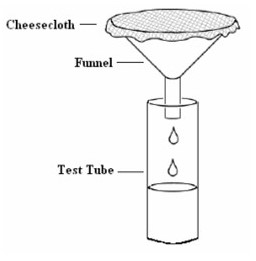
Background: The long, thick fibers of DNA store the information for the functioning of the chemistry of life. DNA is present in every cell of plants and animals. The DNA found in strawberry cells can be extracted using common, everyday materials. Strawberries are soft and easy to pulverize. Strawberries have large genomes; they are octoploid, which means they have eight of each type of chromosome in each cell. Thus, strawberries are an exceptional fruit to use in DNA extraction labs and strawberries yield more DNA than any other fruit (i.e. banana, kiwi, etc.).
We will use an extraction buffer containing salt, to break up protein chains that bind around the nucleic acids, and dish soap which helps to dissolve the phospholipid bilayers of the cell membrane and organelles. This extraction buffer will help provide us access to the DNA inside the cells. DNA is not soluble in alcohol. The colder the alcohol, the less soluble the DNA will be in it. Thus make sure to keep the alcohol in the freezer or on ice.
Materials:
Warning: Isopropyl alcohol is a skin irritant, and inhaling or consuming it can make you sick. Use in a well ventilated space. Alcohols are also flammable and the vapors can ignite. Keep away from open flame.
Procedure:
In 500 mL beaker add
Slowly invert the bottle to mix the extraction buffer.
Why? The physical smashing breaks the plant's cell walls and allows the cytoplasm to leak out.
Why the detergent? The soap breaks down the lipids (fats) in the phospholipid bi-layers of the cell membrane and nuclear membrane. This releases the contents from the cell and the chromosomes containing DNA from the nucleus.

Why? Filtering strains all the large cellular junk out of the mix. The DNA, still tightly wound, is so small it slips through with the liquid and into the test tube.
Caution! From this stage onward, you must be careful not to agitate the mixture.
Why? The polar/non-polar boundary layer causes the DNA to precipitate. The tiny bits of wispy junk floating in the alcohol just above the boundary layer is DNA.
If it didn't work perfectly, don't despair. Most people see the wispy stuff, but you have to get a bit lucky to get the long strands to form
References and Resources:
https://www.scientificamerican.com/article/squishy-science-extract-dna-from-smashed-strawberries/
https://science.wonderhowto.com/how-to/extract-dna-from-strawberry-with-basic-kitchen-items-0140302/
https://www.stevespanglerscience.com/lab/experiments/strawberry-dna/
Video: https://youtu.be/vPGKv53zSRQ
Video: https://youtu.be/usaE_XZx-a8